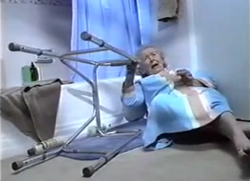At CCM, home and safety are as important to us as to you, so it’s no surprise that it’s a frequent topic in our discussions. I have asked Gregory Peebles to talk about home safety from the vantage point of his experience. Gregory is both a Certified Senior Advisor (CSA) and Certified Dementia Practitioner (CDP) whose work focuses on helping older adults and those who are less independent by providing resources and support to help them live their best life. An Associate Care Manager, Gregory has been a part of our team for over a decade. – Charlotte
Home.
Not only is there no place like it, conveniently located wherever you hang your hat, but it also fits–like an old, comfortable shoe.
One of the things that makes “home” high on our list of favorite places is that home is where things work the way we expect them to work. Reach for it, and whatever it is will be their at your fingertips. We don’t have to think! (or so we (don’t) think…). We just do.
But comfort can be a slippery slope, and it can get us into all kinds of  unplanned trouble. As our older loved ones age, inconveniences in the home can turn into safety hazards. As we watch our parents age, we begin to feel deeply our own mortality and—if we’re not careful—to slip into a pattern of denial, the manifestation of which is the attempt to keep life as it exists in our memories perhaps longer than is advised, all to maintain comfort and status quo. Ironically, this attempt to maintain status quo may end up as a major catalyst to change in our lives unless we bring some consciousness to our scenario.
unplanned trouble. As our older loved ones age, inconveniences in the home can turn into safety hazards. As we watch our parents age, we begin to feel deeply our own mortality and—if we’re not careful—to slip into a pattern of denial, the manifestation of which is the attempt to keep life as it exists in our memories perhaps longer than is advised, all to maintain comfort and status quo. Ironically, this attempt to maintain status quo may end up as a major catalyst to change in our lives unless we bring some consciousness to our scenario.
So we need to look around, and I mean Really Look – not with the eyes we had when we were children in the house, or the eyes we had while we were rearing children, because those eyes both literally and figuratively no longer exist. What do we see? Here’s what I see most when I’m asked for advice:
Stairs
- Steep stairs are not only difficult to manage for less-abled bodies, but they are a huge fall risk.
- Depending on where the family is in its journey, hand rails may be enough, but a stair lift may be necessary.
Cords
- The serpent of the salon, these may be “hiding in plain sight” ready to cause a fall.
- Make sure all floor surfaces are clear in trafficked areas, and, if carpeted, no holes worn through.
Mats
- Scatter rugs become “shatter rugs” if not well-secured to the floor.
- Use adhesives to secure in place, or get rid of any unnecessary rugs.
Washroom
- Water, rugs, and ceramic or steel surfaces all in one place make this the most accident-prone room in the house.
- Make sure it’s well-lit and that the shower has grip bars for balance, or even a chair for stability.
Kitchen
- Timers for appliances are a godsend in this room; auto-off coffee makers and the like will relieve fire anxiety.
- When cabinets are too high to reach, or too low, they may stretch an older adult’s limits. Make sure everything important is in easy reach.
If you’re all set from this list, but still unsure, call us! We’ll be glad to come out and give a look to ease your mind, or to begin the next conversation. In the next blog post, we’ll give you CCM’s best practices for when a change of address for a loved one may be imminent.
Charlotte Bishop is a Geriatric Care Manager and founder of Creative Care Management, certified professionals who are geriatric advocates, resources, counselors and friends to older adults and their families in metropolitan Chicago. Please email your questions to info@creativecaremanagement.com.





